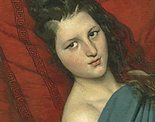The Enlightenment:
Discovering
the World in the
Eighteenth Century.
A New Exhibit
and
Companion Book
from the
British Museum.
The British Museum recently christened the Enlightenment Gallery, "which offers a selection of objects of the kind that inspired eightenth-century scientists to explore the secrets of nature, archeology, antiquity and primitive peoples," Alan Riding of The New York Times writes in a recent article published by The International Herald Tribune.
Mr. Riding's article about the new permanent exhibition, "Enlightenment: Discovering the World in the eighteenth century," not only presents an overview of the British Museum exhibit, but also explores the idea of the Enlightenment from the perspective of contemporary historical criticism. "Was the Enlightenment simply an altruistic mission in pursuit of knowledge?" Mr. Riding asks. "Or was it, as the French philosopher Michel Foucault suggested, an exercise in control and domination?" The answers are interesting.
 "Rediscovering the Enlightenment" in The International Herald Tribune. "Rediscovering the Enlightenment" in The International Herald Tribune.
How Do You Exhibit the Enlightenment?
A companion book has been released to provide a slice of textual context to the Enlightenment Gallery exhibit.  Kim Sloan's Enlightenment: Discovering the World in the Eighteenth Century (British Museum Press, London, 2003), was published to "coincide with and complement this exhibition," John Leigh of Fitzwilliam College, Cambridge, writes in a review in The Art Newspaper.com. "But just how do you exhibit the Enlightenment, an amorphous period traditionally understood to be an episode in the History of Ideas?" Professor Leigh's review answers the question through a succinct explication of Mr. Sloan's book. Kim Sloan's Enlightenment: Discovering the World in the Eighteenth Century (British Museum Press, London, 2003), was published to "coincide with and complement this exhibition," John Leigh of Fitzwilliam College, Cambridge, writes in a review in The Art Newspaper.com. "But just how do you exhibit the Enlightenment, an amorphous period traditionally understood to be an episode in the History of Ideas?" Professor Leigh's review answers the question through a succinct explication of Mr. Sloan's book.
 "The Enlightenment, an English invention: The objects that provoked the thought that changed the world, now on view in the King’s Library at the British Museum." in The Art Newspaper.com. "The Enlightenment, an English invention: The objects that provoked the thought that changed the world, now on view in the King’s Library at the British Museum." in The Art Newspaper.com.
French Paintings
from the
Musée Fabre,
Montpellier
MEDIA RELEASE
from the Embassy of France
Perth, Australia
The National Gallery of Australia’s major summer exhibition, French Paintings from the Musée Fabre, Montpellier, opened on 5 November 2003. The show covers three centuries of painting from the Golden Age in the seventeenth century to the rise of Impressionism in the late nineteenth century, drawing exclusively from the holdings of this well-known French museum.
The Musée Fabre, which opened in 1828, is one of France’s oldest public museums and holds one of the country’s most outstanding art collections, represented in this exhibition by 84 works from 55 French artists.
French Paintings from the Musée Fabre, Montpellier is organised by the National Gallery of Australia in close collaboration with the Musée Fabre and includes the best-known and most representative French painters from the Baroque, Neo-classical, Romantic and Impressionist movements, including key players in art history such as Nicolas Poussin, Eugène Delacroix, Gustave Courbet, Berthe Morisot and Edgar Degas.
"This exhibition presents a unique opportunity for the Australian public to visit and appreciate an outstanding survey of French art and culture," notes Dr Brian Kennedy, Director of the National Gallery of Australia.
Michel Hilaire, Director of the Musée Fabre, says, "The Musée Fabre in Montpellier, France, stands out for the quality of its paintings, amassed over the years by a handful of discerning collectors, all native to the region and proud to contribute towards the creation of a first-class museum outside the nation’s capital."
The artist and collector François-Xavier Fabre founded the museum in 1828 and its collection grew through his generosity and that of such notable benefactors as the wealthy banker Antoine Valedau and Alfred Bruyas, an artist and passionate collector who donated a group of exceptional paintings by Delacroix and Courbet.
A well-known masterpiece from the collection is Courbet’s iconic painting The Meeting or Good Day, Monsieur Courbet. This work documents the close friendship between the painter and patron and is one of the most widely discussed of all Modernist paintings, or, as Michel Hilaire concludes, "one of the gems of the Bruyas collection and a work that is pivotal to the understanding of nineteenth-century Modernism."
The show opens with a wonderful selection of works created under the reign of Louis XIII in the Baroque era, among them exquisite paintings by Poussin and Jacques Stella, and continues with works by Simon Vouet and Laurent de La Hyre, painted during the sumptuous reign of Louis XIV.
The carefully selected works of the eighteenth century reflect the evolution from an official French painting style to an extremely playful and sensual art, characterised by the dazzling paintings of Jean Ranc and Jean-Baptiste Greuze. The nineteenth century is represented by sublime Neo-classical landscapes and conversation pieces. Later works demonstrate the radical innovation and breakthroughs of French art at the threshold of Impressionism and the origin of Modern Art. A splendid group of paintings by Delacroix, Courbet, Morisot and Degas herald the significant changes in French society and their impact on daily life, and superbly illustrate that these artists captured the world in a new, spontaneous way, translating reality into daring compositions full of shimmering light and vivid colours.
|

